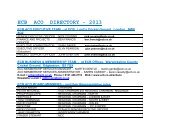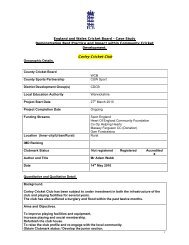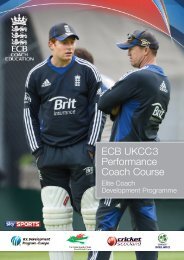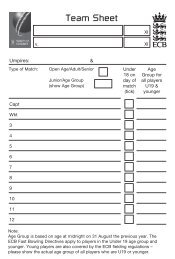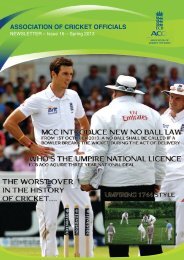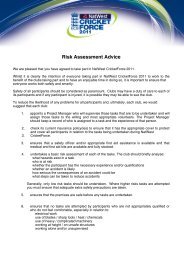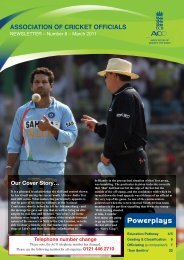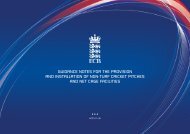Indoor Sports Halls with Cricket Provision [TS3] - Ecb - England and ...
Indoor Sports Halls with Cricket Provision [TS3] - Ecb - England and ...
Indoor Sports Halls with Cricket Provision [TS3] - Ecb - England and ...
You also want an ePaper? Increase the reach of your titles
YUMPU automatically turns print PDFs into web optimized ePapers that Google loves.
03 Key Dimensions & RequirementsUse of Curved Tracks to Avoid Clashes Between Nets<strong>and</strong> Doors / Viewing Windows / <strong>Sports</strong> Equipment etc.1.3m min. for nets between A <strong>and</strong> wallcrossovercrossovercrossovercrossovercrossovercrossovercrossovercrossoverABBCsidewayshingedmatchplaybasketballgoalTracks A - Do not need any curves.Tracks B - Require curves to avoid thesideways hinged matchplaybasketball goals.Curves are not required if roofretractable goals are installed.Tracks C - Require curves to avoid theviewing window.doorscrossovercrossovercrossovercrossoverCDviewingwindowTracks D - Require curves to avoid theviewing window <strong>and</strong> doors.1.85m min. between wall <strong>and</strong> D for divisionnet on U-shaped trackwayECB Facility Briefs <strong>and</strong> Guidance Notes for <strong>Indoor</strong> <strong>Sports</strong> <strong>Halls</strong> <strong>with</strong> <strong>Cricket</strong> <strong>Provision</strong>Page 07ECB_<strong>TS3</strong> © 2008 ECB
04 Netting, Blinkers, Screening, Tracking <strong>and</strong> FittingsThe net system used shall conform to the requirements indicated in this document <strong>and</strong> the latest edition of:- BS EN 1892 Gymnasium Equipment Part 2. Particular Requirements Section 2.11. Specification for practice<strong>and</strong> games netting <strong>and</strong> supporting tracking.This section is divided into Performancerequirements, <strong>and</strong> Guidance.PerformanceThe structure of the net system nets,blinkers, screening, tracking <strong>and</strong> fittingsshould be able to <strong>with</strong>st<strong>and</strong> cricket ballshitting the net <strong>and</strong> supporting structureswhen subjected to normal use. Balls shouldnot pass under, over, through or between thenets, screening etc. Horizontal nets shouldbe attached to vertical nets <strong>and</strong> balls shouldnot pass between them. Balls should notbecome entrapped in the net system duringnormal use.The netting should <strong>with</strong>st<strong>and</strong> balls impactingit, <strong>and</strong> players running into it.Components should be UV resistant <strong>and</strong> notdegrade or weaken as a result of exposureto sunlight.The tracking holding the netting should notbe damaged by cricket balls impacting it orplayers colliding <strong>with</strong> it.GuidanceThe individual net bay is separated fromthe adjoining bays by tracked side nettingextended from end to end. The most efficientmethod is independent overhead tracks,which allows nets to be drawn independently<strong>and</strong> which allows for flexible usage.It is recommended that nets be suspendedfrom a heavy-duty aluminium tracking<strong>and</strong> trolley system which conforms to BSEN 1892. This type of system requires anindependent overhead net, below which thetracking system is fixed; there should beno space between the roof netting <strong>and</strong> thetracking system through which a ball canpass into adjacent nets.It is recommended that white polymer nettingbe used for the roof netting <strong>and</strong> it be eithersewn or roof fitted <strong>with</strong>, 50 mm knot (knotto knot) or 40 mm knotless (weld to weld)square mesh, <strong>with</strong> the leading edges tapedfor reinforcement.If the roof net is fixed to the side net theside net cannot be drawn independently<strong>and</strong> whilst this style of arrangement may beappropriate if the tracking has to be to befitted to the roof joists well above the normalheight requirements for roof netting it shouldotherwise be avoided.The side netting should be long enough forat least 0.3m <strong>and</strong> no more than 0.5m ofslack/drape to rest on the floor. This createsadded weight <strong>and</strong> prevents the net frombillowing out when struck by the ball (abillow of no more than 1.3 metres should beachieved when in service) otherwise it willinterfere <strong>with</strong> activities in adjacent nets <strong>and</strong>walkways forming a potential trip hazard.ECB Facility Briefs <strong>and</strong> Guidance Notes for <strong>Indoor</strong> <strong>Sports</strong> <strong>Halls</strong> <strong>with</strong> <strong>Cricket</strong> <strong>Provision</strong>Page 08ECB_<strong>TS3</strong> © 2008 ECB
04 Netting, Blinkers, Screening, Tracking <strong>and</strong> FittingsIt is recommended that 50 mm knotted or 40mm knotless white polymer netting mesh beused.All sports hall netting, canvas, storagepouches, etc should be made of fireretardant material in accordance <strong>with</strong> BS5867 Part 2.The netting shall not be hung too taut toprevent balls rebounding dangerously.A blinker similar system is recommended forthe back netting behind the bowler to createa good visual background <strong>and</strong> to reduce therisk of injury from balls being driven down thenet bay.It is recommended that the bowling endblinker be 3m high either as a Velcroattachment or sewn in to the netting.Blinkers should be fitted to all practice nets.(Either heavy white canvas or polymer). Theyshould be suspended on lanyard cordsthreaded through the net (not fixed to the netas this will, overtime create sag) both side<strong>and</strong> rear nets around the batsman/wicketkeeper. It is recommended that the blinkersextend 5m in front of the batsman 7.72mfrom the rear net, <strong>and</strong> to a height of at least1.8m.ECB Facility Briefs <strong>and</strong> Guidance Notes for <strong>Indoor</strong> <strong>Sports</strong> <strong>Halls</strong> <strong>with</strong> <strong>Cricket</strong> <strong>Provision</strong>Page 09ECB_<strong>TS3</strong> © 2008 ECB
04 Netting, Blinkers, Screening, Tracking <strong>and</strong> FittingsAll the definitions are not included in this document but may be found in otherdocuments associated <strong>with</strong> cricket <strong>and</strong> British St<strong>and</strong>ards.Net System: a net system is a single unitfrom a performance point view.Net Bulge (net billowing): the extent towhich the nets move horizontally from thevertical when an object hits it.Lacing Nets: the fastening of nets to eachother, to supporting frames or structures <strong>with</strong>a lace threaded <strong>and</strong> wound through the nets.Ties: the fastening of nets to each other, tosupports, bars <strong>and</strong> other structures, <strong>with</strong>individual sections of cord, string, yarn etc.Net Aperture: the size of the mesh makingup the netting.Drag: the amount of netting which lies on thefloor subsequent to the fixing of the nettingunit to the overhead tracking.Selvedge: a continuous cord attached to theperiphery of the net.Drape: netting has a tendency to produce acurtain effect when suspended from trackingor a tension wire.Meshes: a collection of apertures betweenthe cords making up the net.Net Stretch: increase in size <strong>and</strong> length offibres making up the netting.Fittings: cables <strong>and</strong> any other materialsused to support the net system.Screening: a solid curtain manufacturedfrom fibres.Blinkers: term used for screening.Track: nets are attached to track by runners.This allows the nets to be drawn along thetrack.Fixings: brackets, bolts, ties, etc that holdthe net system together.ECB Facility Briefs <strong>and</strong> Guidance Notes for <strong>Indoor</strong> <strong>Sports</strong> <strong>Halls</strong> <strong>with</strong> <strong>Cricket</strong> <strong>Provision</strong>Page 10ECB_<strong>TS3</strong> © 2008 ECB
05 Playing SurfaceGuidance should include how the system isused <strong>and</strong> the activities required to maintainit in good working order for the life of theinstallation. It should include: -Netting:• Maintaining the nets at the appropriatelevel of tension.• Keeping them clean <strong>and</strong> free from dust• Repairing damaged netting• Preventing nets from becoming slack• Preventing nets from saggingTracking, cables, fixings, fittings:Maintaining the tracking, <strong>and</strong> if applicablecables, including: -• Removal of dirt to prevent a build-upSurface:• Cleaning• Marking• Removal of debris• Application of colour coats (whenrequired)• Replacement sections (when required)Any other maintenance work required tokeep the facility operational at all times.The desired frequency of operations shouldbe indicated so that they form part of aregular maintenance schedule the user canrefer to in order to manage <strong>and</strong> monitorthe extent of the work required <strong>and</strong> makeavailable the resources to do the work.• Lubrication all movable parts• CleaningECB Facility Briefs <strong>and</strong> Guidance Notes for <strong>Indoor</strong> <strong>Sports</strong> <strong>Halls</strong> <strong>with</strong> <strong>Cricket</strong> <strong>Provision</strong>Page 13ECB_<strong>TS3</strong> © 2008 ECB
06 Internal <strong>and</strong> External DoorsRefer to current Sport <strong>Engl<strong>and</strong></strong> guidelines.07 Internal Finishes (Colours)Refer to current Sport <strong>Engl<strong>and</strong></strong> guidelines.08 FlooringRefer to Performance St<strong>and</strong>ard for <strong>Indoor</strong><strong>Cricket</strong> Surfaces. See page 22ECB Facility Briefs <strong>and</strong> Guidance Notes for <strong>Indoor</strong> <strong>Sports</strong> <strong>Halls</strong> <strong>with</strong> <strong>Cricket</strong> <strong>Provision</strong>Page 14ECB_<strong>TS3</strong> © 2008 ECB
09 HeatingMost multi purpose sports hall often requirelittle heating <strong>and</strong> benefit from a system <strong>with</strong>a fast response time. There are two optionsavailableGas fired radiant <strong>with</strong> 2 branches <strong>with</strong> supply<strong>and</strong> extract fans in the end wallsOrDucted warm air delivering heated airthrough Air H<strong>and</strong>ling Units (AHU) whichshould be indirect gas fired to reduce boilercapacity. Ideally this heating system should100% recirculation <strong>with</strong> ventilation providedby other meansHeating System ControlsFor both heating options, heating will becontrolled by presence detectors <strong>and</strong>thermostat <strong>and</strong> ventilation by air qualityHeating Design Parameters• Design Room temperature = 16 deg C• Specialist <strong>Cricket</strong> Schools = 16 deg Cto 20 deg C• Sport <strong>Engl<strong>and</strong></strong> ‘Optimum <strong>Sports</strong> hall’ =12 deg C to 20 deg CECB Facility Briefs <strong>and</strong> Guidance Notes for <strong>Indoor</strong> <strong>Sports</strong> <strong>Halls</strong> <strong>with</strong> <strong>Cricket</strong> <strong>Provision</strong>Page 15ECB_<strong>TS3</strong> © 2008 ECB
10 VentilationHigh ventilation rates will be needed for asports hall, but heating large quantities ofoutside air is energy intensive. Consequently,the strategy should seek to decouple theheating <strong>and</strong> the ventilation so that thespaces may be maintained at comfortabletemperatures ready for use, <strong>with</strong> ventilationlinked to occupancy. If ventilation rates arecoupled to air quality control, then fresh air isprovided only at the required rate, saving fanpower <strong>and</strong> heating energy.A properly designed multi-purposesports hall, which meets the ventilationrequirements for other sports (basketball,badminton etc), should be adequate forcricket practice <strong>with</strong>out further modification.Ventilation Design Parameters:Design ventilation rate 1.5 Air changes perhour (ACHR)Low levels of fresh air can be providedpassively through motorised dampers athigh level, while additional ventilation couldbe provided by fans at high level which alsoprovide large volumes of fresh air in summerto cool the space.ECB Facility Briefs <strong>and</strong> Guidance Notes for <strong>Indoor</strong> <strong>Sports</strong> <strong>Halls</strong> <strong>with</strong> <strong>Cricket</strong> <strong>Provision</strong>Page 16ECB_<strong>TS3</strong> © 2008 ECB
11 Lighting<strong>Indoor</strong> cricket schools should be illuminated using natural daylight. However, suchan approach does require careful shading design to ensure that direct sunlight isexcluded from the playing area at all times.<strong>Sports</strong> halls <strong>with</strong> rooflights <strong>and</strong> glazinglocated in end walls may need suitableblinds/shades installed to exclude sunlightfrom the playing area – particularly lowsun at particular times of the day <strong>and</strong> year.Consequently, the design of the shading forcricket practice will need to be assessed ona case by case basis.Artificial LightingIn multi-purpose sports halls lightingshould use fluorescent light fittings <strong>with</strong>multiple lamps, which reduces glare <strong>and</strong>maintains uniformity at different illuminationlevels. The required light level should beprovided by lines of fluorescent light fittingsrunning alongside each wicket <strong>and</strong> fixedto the structure. Some assessment <strong>and</strong>coordination of the locations of the existingsports hall lighting, heating system (e.g.radiant tubes etc), net tracks <strong>and</strong> the wicketwill be necessary. Consequently, the designof the lighting for cricket practice will need tobe assessed on a case by case basis.Wall ReflectanceFor cricket practice, light wall colours arepreferred. Ideally, a reflectance of 0.7 shouldbe achieved <strong>with</strong> white painted walls, soffit/ceiling so as to provide adequate contrast<strong>with</strong> <strong>and</strong> improved visibility of the ball.Some multi-purpose sports halls may befinished in other, darker, colours <strong>and</strong> it maybe necessary to use a different coloured ball.Darker wall <strong>and</strong> ceiling colours also have alower reflectance than lighter colours whichmust be taken into account when designingthe cricket practice area lighting.Lighting Design ParametersThese are the lighting levels, measured atpitch level, required over the practice net/playing area (Wicket <strong>and</strong> run up):• Low-level Club/Local ClubDesign illumination: 750 lux averageDesign uniformity: min/ave = 0.8• Mid-Level Competition.Regional/Club levelDesign illumination: 1000 lux averageDesign uniformity: min/ave = 0.8• Top-Level Competition.International/National levelDesign illumination: 1500 lux averageDesign uniformity: min/ave = 0.8ECB Facility Briefs <strong>and</strong> Guidance Notes for <strong>Indoor</strong> <strong>Sports</strong> <strong>Halls</strong> <strong>with</strong> <strong>Cricket</strong> <strong>Provision</strong>Page 17ECB_<strong>TS3</strong> © 2008 ECB
11 LightingMechanical & Electrical ConsiderationArea for M & Etypically 7.7m to 9.2mmin. clear dependingon sports playedDistance to plant <strong>and</strong> equipmentwill vary. Consult <strong>with</strong> nettingspecialists <strong>and</strong> mechanical <strong>and</strong>electrical consultants.Consideration must be given to spacerequired for the safe installation,operation<strong>and</strong> maintenance of mechanical <strong>and</strong>electrical plant <strong>and</strong> equipment, <strong>and</strong> nets.Specialist advice should always be soughtprior to fixing overall dimensions, in particular<strong>with</strong> regard to distances between radiant gasheaters <strong>and</strong> net systems.SECTION THROUGH NET LANESECB Facility Briefs <strong>and</strong> Guidance Notes for <strong>Indoor</strong> <strong>Sports</strong> <strong>Halls</strong> <strong>with</strong> <strong>Cricket</strong> <strong>Provision</strong>Page 18ECB_<strong>TS3</strong> © 2008 ECB
12 <strong>Indoor</strong> cricket for disabled peopleECB advises that players <strong>with</strong> many differenttypes of impairments enjoy the game on aregular basis. Players who use a wheelchairare just as likely to use indoor facilities inthe same way that a mainstream cricketerwould do so. Matches will be played usingthe full hall <strong>and</strong> net lanes will also be used forpractice by players using wheelchairs. Thereis no need for any specific design alterationto accommodate wheelchair players.13 LiftsECB guide to refer to current Sport <strong>Engl<strong>and</strong></strong> guidelines.14 Lockers<strong>Cricket</strong>ers require space to store personalcricket equipment (usually ‘soft bags) <strong>and</strong>valuable outside the changing rooms. Ideallythis should be <strong>with</strong>in, or adjacent, to themain hall <strong>and</strong> <strong>with</strong>in sight of the players/coaches. Refer to Sport <strong>Engl<strong>and</strong></strong> guides forlockers.ECB Facility Briefs <strong>and</strong> Guidance Notes for <strong>Indoor</strong> <strong>Sports</strong> <strong>Halls</strong> <strong>with</strong> <strong>Cricket</strong> <strong>Provision</strong>Page 19ECB_<strong>TS3</strong> © 2008 ECB
15 <strong>Cricket</strong> specific storageStorage of cricket specific equipment (Mats,bowling machines <strong>and</strong> floor cleaners etc) willbe required separately.16 Spectator Seating / social areasECB guide to note that spectators should beoutside of the playing hall, ideally be behindthe bowlers arm <strong>and</strong> at an elevated level toassist viewing. Spectators must beprotected from ball impact17 Reception areasECB to refer to Sport <strong>Engl<strong>and</strong></strong> guidance.Note to be added that sufficient space isneeded for 35 players <strong>with</strong> parents on hourlyrotations outside of the practice area.ECB Facility Briefs <strong>and</strong> Guidance Notes for <strong>Indoor</strong> <strong>Sports</strong> <strong>Halls</strong> <strong>with</strong> <strong>Cricket</strong> <strong>Provision</strong>Page 20ECB_<strong>TS3</strong> © 2008 ECB
Performance st<strong>and</strong>ards forindoor cricket surfacesecb.co.ukECB Facility Briefs <strong>and</strong> Guidance Notes for <strong>Indoor</strong> <strong>Sports</strong> <strong>Halls</strong> <strong>with</strong> <strong>Cricket</strong> <strong>Provision</strong>Page 21ECB_<strong>TS3</strong> © 2008 ECB
01 Introduction <strong>and</strong> ScopeThis St<strong>and</strong>ard describes the requirements for synthetic surfaces designed for indoor cricket.It is based on BS EN 14904 Surfaces for sports areas — <strong>Indoor</strong> surfaces for multi-sports use —Specification, but includes properties specifically required by the game of cricket.The St<strong>and</strong>ard covers three types of sports hall flooring systems:• sports hall flooring designed to be laid as a continuous systemthroughout a sports hall allowing a range of sports, including cricket,to be played(1). Continuous systems are required to satisfy theperformance requirements of batting <strong>and</strong> bowling ends;• specialist cricket surfaces used in dedicated cricket halls <strong>with</strong> differentunderlay constructions for the batting <strong>and</strong> bowling areas. Each sectionof the surfacing shall satisfy the relevant performance requirements forends on which it is intended to be laid;(1) This St<strong>and</strong>ard only addresses the needs of the game of cricket.The suitability of a floor meeting this st<strong>and</strong>ard for other sports needsto be determined by the organisation proposing to install the floor.(2) A roll out mat found to be suitable on one type of sports hall will notnecessarily provide satisfactory performance on a different type ofsports hall floor.• roll out mats that, in conjunction <strong>with</strong> the sports hall floor on whichthey are laid, are designed to provide a suitable surface for crickettraining activities. In such cases the ball/surface <strong>and</strong> player/surfaceinteraction of the mat shall be assessed in conjunction <strong>with</strong> the flooron which it is designed to be laid (2). The batting ends of mats arerequired to satisfy the performance requirements for batting ends <strong>and</strong>the bowling ends are required to satisfy the performance requirementsfor bowling ends.ECB Facility Briefs <strong>and</strong> Guidance Notes for <strong>Indoor</strong> <strong>Sports</strong> <strong>Halls</strong> <strong>with</strong> <strong>Cricket</strong> <strong>Provision</strong>Page 22ECB_<strong>TS3</strong> © 2008 ECB
02 Normative ReferencesTest methods from other publications are incorporates into this St<strong>and</strong>ard by dated or undatedreference. Where dated references are used, subsequent amendments to or revisions of any ofthese publications will apply to this St<strong>and</strong>ard only when incorporated into it by amendment orrevision. For undated references, the latest edition of the publication referred to applies.ECB Facility Briefs <strong>and</strong> Guidance Notes for <strong>Indoor</strong> <strong>Sports</strong> <strong>Halls</strong> <strong>with</strong> <strong>Cricket</strong> <strong>Provision</strong>Page 23ECB_<strong>TS3</strong> © 2008 ECB
03 Definitions03.1 Playing surfaceAn area of synthetic surfacing, together <strong>with</strong> its supporting layers, thatis used for cricket. The area comprises two principal playing areas,a batting end <strong>and</strong> a bowling end. These are located <strong>with</strong>in syntheticsurrounds.03.2 Batting endAn area measuring a minimum of 10m in length in front of the poppingcrease <strong>and</strong> a minimum of 1.5m behind the wicket (stumps) on which thebatsman st<strong>and</strong>s <strong>and</strong> the ball pitches when bowled.03.3 Bowling endAn area measuring a minimum of 4m in length in front of the bowler’screase <strong>and</strong> a minimum 6m behind the bowler’s crease on which thebowler runs <strong>and</strong> delivers the ball.03.4 Synthetic surrounds03.5 Point-elastic sports floor<strong>Sports</strong> floor, to which the application of a point force causes deflectiononly at or close to the point of application of the force.03.6 Area-elastic sports floor<strong>Sports</strong> floor, to which the application of a point force causes deflectionover a relatively large area around the point of application of the force03.7 Combined-elastic sports floorArea-elastic sports floor <strong>with</strong> a point-elastic top layer, to which theapplication of a point force causes both localised deflection <strong>and</strong>deflection over a wider area03.8 Mixed-elastic sports floorPoint-elastic sports floor <strong>with</strong> a synthetic area-stiffening componentThe areas located around <strong>and</strong> between the batting <strong>and</strong> bowing ends.Synthetic surroundsNetBatting endBowler’s run-upFigure 1 - areas of surface forming the playing area (colours <strong>and</strong> hatching for illustration only)ECB Facility Briefs <strong>and</strong> Guidance Notes for <strong>Indoor</strong> <strong>Sports</strong> <strong>Halls</strong> <strong>with</strong> <strong>Cricket</strong> <strong>Provision</strong>Page 24ECB_<strong>TS3</strong> © 2008 ECB
04 ClassificationSurfaces are classified by their intended use <strong>and</strong> performancecharacteristics <strong>and</strong> not by materials or construction. There are twoprincipal categories:1. Club <strong>and</strong> Educational2. First Class <strong>Cricket</strong> & Centres of ExcellenceBoth of which may be used for practice, coaching <strong>and</strong> general training.ECB Facility Briefs <strong>and</strong> Guidance Notes for <strong>Indoor</strong> <strong>Sports</strong> <strong>Halls</strong> <strong>with</strong> <strong>Cricket</strong> <strong>Provision</strong>Page 25ECB_<strong>TS3</strong> © 2008 ECB
05 Performance Requirements05.1 Ball / surface interaction05.1.1 Ball reboundBall rebound shall be measured from a drop height of 2000mm + 10mmin general accordance <strong>with</strong> BS EN 12235 using a cricket ball complying<strong>with</strong> BS 5993 <strong>and</strong> having a rebound on a rigid concrete floor of640mm + 30mm. The rebound shall be expressed as the absoluterebound in mm.For area-elastic <strong>and</strong> combined-elastic sports surfaces, the test pieceshall be a sample of the complete system measuring 3.5 m by 3.5m, assembled in accordance manufacturer’s stated method, <strong>with</strong> themanufacturer’s requirements. For point-elastic <strong>and</strong> mixed-elastic sportssurfaces, the test piece shall be a piece of the surface of minimum size1.0 m by 1.0 m, in combination <strong>with</strong> the supporting layers to be usedin service <strong>and</strong> using the method of attachment in accordance <strong>with</strong> themanufacturer’s instructions.Note: a Reader Grade 1 County Ball has been found to satisfy these requirements.The ball rebound of batting ends shall satisfy the requirements of Table 1.All test positions shall fall <strong>with</strong>in the specified range. The maximumindividual result at any test position shall be no more than 1.5 times theminimum individual result at the test position.The overall mean for all test positions shall be calculated. The variationfrom the overall mean of any test position shall be no greater than +50mm of the overall mean.05.1.2 Surface paceThe pace of some forms of indoor sports hall flooring may be consideredtoo fast for indoor cricket. At present there is no suitable test forassessing the pace of a cricket surface so limits of acceptability cannotbe set. The ECB wish to rectify this <strong>and</strong> has commissioned researchto develop a test <strong>and</strong> establish limits of acceptability based on naturalgrass cricket pitches. It is hoped this work will be completed by the endof 2008, at which point this st<strong>and</strong>ard will be updated. In the mean timefacility operators are advised to seek specialist guidance on whether thepace of indoor surfaces they are considering is suitable for their intendedneeds.05.1.3 Surface hardness – batting endsTable 1 - Ball rebound requirementsClub / Educational240mm – 520mmCentre of Excellence & First Class <strong>Cricket</strong>320mm – 560mmWhen tested by the method described in Appendix B the mean CleggImpact Value (in g) for each test position on a batting end shall be greaterthan 100 gravities.Installed surfaces shall be tested in the positions shown in Appendix A.Installed surfaces shall be tested in the positions shown in Appendix A.Laboratory tests shall be made in similar positions proportioned to suitthe test piece size.ECB Facility Briefs <strong>and</strong> Guidance Notes for <strong>Indoor</strong> <strong>Sports</strong> <strong>Halls</strong> <strong>with</strong> <strong>Cricket</strong> <strong>Provision</strong>Page 26ECB_<strong>TS3</strong> © 2008 ECB
05 Performance Requirements05.2 Player surface interaction05.2.1 Shock absorption – bowler’s run-upWhen tested by the method described in BS EN 14808 the ForceReduction of bowling ends shall be between 25% <strong>and</strong> 55%.Installed surfaces shall be tested in the positions shown in AppendixA. No individual result shall differ from the mean of all the test areas bymore than ± 5 units.05.2.2 Vertical deformation – batting end, bowler’s run-up<strong>and</strong> synthetic surroundsWhen tested by the method described in BS EN 14809, the verticaldeformation of batting <strong>and</strong> bowling ends shall not exceed 3.5mm.05.2.3 Friction – batting ends, bowler’s run-ups <strong>and</strong>synthetic surroundsWhen tested by the method described in BS EN 13036-4 using the CENrubber under dry conditions, the mean result shall be between80 <strong>and</strong> 110.When different forms of surfacing are used for the batting or bowlingends <strong>and</strong> synthetic surrounds the maximum difference between the slipresistance of two surfaces shall be four units.ECB Facility Briefs <strong>and</strong> Guidance Notes for <strong>Indoor</strong> <strong>Sports</strong> <strong>Halls</strong> <strong>with</strong> <strong>Cricket</strong> <strong>Provision</strong>Page 27ECB_<strong>TS3</strong> © 2008 ECB
06 Material Requirements06.1 Resistance to wearWhen tested by the method described in BS EN ISO 5470-1, usingH18 wheels <strong>with</strong> a 1 kg load, the maximum loss in mass per 1 000cycles of synthetic surfaces shall be 1 000 mg.When tested by the method described in BS EN 13672 the percentagemass loss after 2000 cycles of synthetic turf <strong>and</strong> textile surfacesshall be equal to or less than 5%.06.2 Resistance to a rolling load – continuous surfaces onlyWhen tested by the method described in BS EN 1569, the minimumresistance of continuous surfaces shall be 1500 N, the maximumindentation shall be 0.5 mm under a 300 mm straight edge <strong>and</strong> noperceivable damage shall be observed after the test.NOTE This property is important to ensure that continuous surfaces laid throughout asports hall will not be damaged by equipment or seating that might be moved around on it.06.3 Resistance to indentationWhen tested by the method described in BS EN 1516, the meanresidual indentation measured 5 min. after removal of the load shallbe reported <strong>and</strong> the mean residual indentation measured 24 h afterremoval of the load shall be ≤ 0.5 mm. For area-elastic sports floorsthe test shall be made on the upper layer supported on a rigid structureonly.06.5 Specular glossWhen tested by the method described in ISO EN 2813 using anangle of incidence of 85°, the specular gloss shall be ≤ 30 for mattsurfaces <strong>and</strong> ≤ 45 for lacquered surfaces.06.6 Reaction to fireIf a claim for reaction to fire performance is made, the sports surfaceshall be tested <strong>and</strong> classified using the procedures specified in BSEN 14904.If it is decided to make no claim for reaction to fire performance, i.e.it is decided to place a product on the market as Class Ffl, no testingis required.06.7 Formaldehyde emissionWhen formaldehyde-containing materials have been added to thesurface as a part of the production process, the product shall betested <strong>and</strong> classified into one of two classes: E1 or E2, as specifiedin BS EN 14904.06.8 Content of pentachlorophenolThe surfacing shall not contain pentachlorophenol or a derivativethereof as a component in the production process of the product orof its raw materials. In cases where verification is required the proceduresdescribed in BS EN 14904 shall be used.ECB Facility Briefs <strong>and</strong> Guidance Notes for <strong>Indoor</strong> <strong>Sports</strong> <strong>Halls</strong> <strong>with</strong> <strong>Cricket</strong> <strong>Provision</strong>Page 28ECB_<strong>TS3</strong> © 2008 ECB
07 Construction Requirements07.1 Surface regularity – batting ends, bowler’s run-ups <strong>and</strong>synthetic surroundsWhen tested by the method described in BS EN 13036-7 themaximum undulation shall not exceed 2 mm under 0.3 m straightedge <strong>and</strong> 6 mm under a 3 m straight edge.07.2 Slope – batting ends, bowler’s run-ups <strong>and</strong> syntheticsurrounds<strong>Indoor</strong> cricket surfaces shall be installed flat.08 Test ConditionsLaboratory tests shall be made at an ambient laboratory temperatureof 23 ± 2ºC.Test specimens shall be conditioned for a minimum of 3 hours at thelaboratory temperature prior to test.Tests on an installed floor shall be made when the ambienttemperature of the sports hall is in the range 12°C to 25°C.09 Test LaboratoriesTests for ECB approval shall only be made by ECB approvedtest laboratories.ECB Facility Briefs <strong>and</strong> Guidance Notes for <strong>Indoor</strong> <strong>Sports</strong> <strong>Halls</strong> <strong>with</strong> <strong>Cricket</strong> <strong>Provision</strong>Page 29ECB_<strong>TS3</strong> © 2008 ECB
Appendix A Site TestsTests shall be carried out in the positions detailed below or in thecase of a dispute in the area of concern.PropertyBall reboundSurface hardness(pitch of the ball area)Slip resistanceTest locationFive individual tests across the playingarea in each test segment a to e asshown on Figure 1Segments a to e as shown on Figure 1Segments a, c <strong>and</strong> e as shown in Figure1 <strong>and</strong> positions 1, 3 <strong>and</strong> 5 as shown inFigure 2Shock absorption Each position shown in Figure 2.DeformationSegments a, c <strong>and</strong> e as shown in Figure1 <strong>and</strong> positions <strong>and</strong> 1, 3 <strong>and</strong> 5 as shownin Figure 2The surface regularity of the playing surface <strong>and</strong> surrounds shall bemeasured over the entire area; both along the length <strong>and</strong> across thewidth. The position <strong>and</strong> magnitude of any undulations found thatexceed the specified maximums shall be recorded <strong>and</strong> detailed in thetest report.ECB Facility Briefs <strong>and</strong> Guidance Notes for <strong>Indoor</strong> <strong>Sports</strong> <strong>Halls</strong> <strong>with</strong> <strong>Cricket</strong> <strong>Provision</strong>Page 30ECB_<strong>TS3</strong> © 2008 ECB
Figure 1 – tests positions1.5ma b c d eECB Facility Briefs <strong>and</strong> Guidance Notes for <strong>Indoor</strong> <strong>Sports</strong> <strong>Halls</strong> <strong>with</strong> <strong>Cricket</strong> <strong>Provision</strong>Page 31ECB_<strong>TS3</strong> © 2008 ECB
Figure 2 – tests positions1 0.6m 234 1m5ECB Facility Briefs <strong>and</strong> Guidance Notes for <strong>Indoor</strong> <strong>Sports</strong> <strong>Halls</strong> <strong>with</strong> <strong>Cricket</strong> <strong>Provision</strong>Page 32ECB_<strong>TS3</strong> © 2008 ECB
Appendix B Method of test for determination of surface hardness1 PrincipleA cylindrical mass is released from a st<strong>and</strong>ard height <strong>and</strong> its peakdeceleration during impact <strong>with</strong> the surface is recorded.2 ApparatusA Clegg Impact Soil Tester shall be used. The apparatus consists of acylindrical compaction hammer <strong>with</strong> a mass of 2.25kg <strong>and</strong> a diameterof 50mm attached to a piezoelectric accelerometer which feedsinto a peak level digital meter. The peak deceleration of the hammeron impact <strong>with</strong> the ground shall be displayed in units of gravities.3 ProcedureEnsure that the guide tube is held vertically <strong>and</strong> drop the compactionhammer down the tube from a height of 450+10mm. After the impactof the hammer on the surface record the peak deceleration inunits of gravities.Repeat the procedure fives times in each test position moving theguide tube by at least 100mm so that the compaction hammer doesnot impact <strong>with</strong> the surface on the same spot twice.4 Expression of ResultsCalculate the mean hardness value of the five individual impacts foreach test position.ECB Facility Briefs <strong>and</strong> Guidance Notes for <strong>Indoor</strong> <strong>Sports</strong> <strong>Halls</strong> <strong>with</strong> <strong>Cricket</strong> <strong>Provision</strong>Page 33ECB_<strong>TS3</strong> © 2008 ECB


![Indoor Sports Halls with Cricket Provision [TS3] - Ecb - England and ...](https://img.yumpu.com/49070696/1/500x640/indoor-sports-halls-with-cricket-provision-ts3-ecb-england-and-.jpg)
